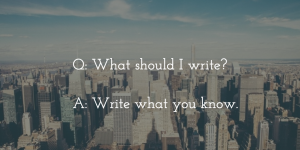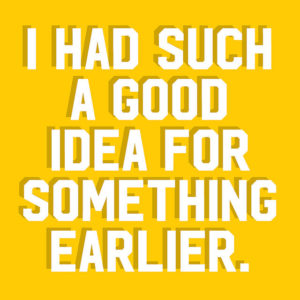I’m going to stretch the truth a bit and say every English teacher has heard a student ask: What should I write? And many teachers have responded: “Write what you know.”
I call it WWYK. For many writers this bit of wisdom falls into the best/worst advice ever category.
 It’s cliché and a bit confusing.
It’s cliché and a bit confusing.
It forces folks to frantically mine their perfectly normal childhood memories for dark, dysfunctional secrets.
I like WWYK because it turns the key in the ignition. Everybody knows something, right?
Some folks think WWYK is always autobiographical and worry that their lives aren’t rich enough for the page. Please don’t try to be Alan Cummings and pen Not My Father’s Son. I sincerely hope your father (who decided that you were a product of an affair) didn’t abuse you.
And no one is expecting another My Beloved World. That’s Supreme Court Justice Sonia Sotomayor’s journey about growing up in a housing development in the Bronx, graduating from Yale Law and landing a seat on the federal bench.
Go ahead and borrow even the smallest detail from your life to craft a must-read tale. One of my most delicious childhood memories was having unlimited access to Baskin-Robbins ice cream at my father’s store. (This is probably why I’m lactose intolerant now.) Imagine how cool it would be if I wrote about a spy, posing as a loving mom, who used an ice cream shop for espionage.
That’s just one of many ideas.
Think of WWYK as a ramp onto the writing highway. It’s an easy access point for anyone, no matter if you’re a Black male teen living in Texas or an Asian married mother of six in Alaska. What you know varies by age, race and gender. Oh, and let’s not forget about experience, location and perspective. There are lots of variables.
The problem is folks get touchy after hearing critiques about real-life scenes in fiction or non-fiction. Fact: The analysis can’t be

ignored simply because the smash and grab robbery happened exactly how you wrote it. What if the dialogue was stale? What if the sequence of events didn’t ring true? What if the overall timeline didn’t make sense?
This isn’t a pass to slap together sloppy work, skip research and run wild with inaccuracies. Don’t think about dropping a Xbox One into a piece set in 1980, the year Toru Iwatani gifted us Pac-Man. Readers (and diehard Pac-Man fans) will happily scorch you in a grease fire called The Internet.
WWYK is permission to explore familiar people, places and things and in an unexpected way.
Perfect example: Ta-Nehisi Coates and Neal Shusterman both took home trophies at the 66th Annual National Book Awards in the non-fiction and young people’s literature categories, respectively.
Coates’ provocative Between the World and Me examines race in America. What he knew was this: His unarmed college buddy Prince Jones was killed at age 25 by a police officer.
Shusterman’s fictional look at mental illness in Challenger Deep was especially moving also because of a personal experience. What he knew was this: His son Brendan (who illustrated the book) had struggled with mental illness.
Coates and Shusterman are proof that WWYK can be used for the greater good.
It’s merely a starting point for your imagination.
What do you know?
